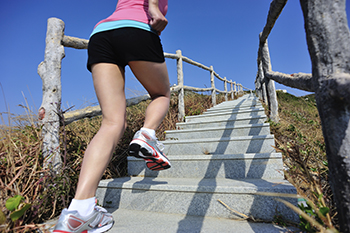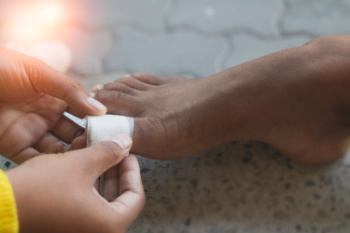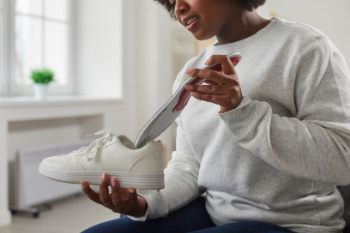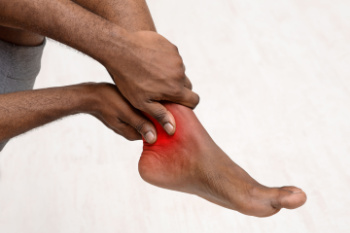Items filtered by date: August 2024
Running Woes

Runners often experience a variety of foot problems due to the repetitive stress and impact involved in the sport. Issues like blisters, toenail damage, and stiff big toe joints are frequent, in addition to more severe conditions like plantar fasciitis and stress fractures. The feet endure significant pressure during running, making them particularly vulnerable to injuries. When not properly treated, these injuries can lead to chronic pain or long-term mobility issues. To prevent foot problems, it is important to wear appropriate footwear, gradually increase mileage, and pay attention to any early signs of discomfort. Regularly stretching and strengthening foot muscles can also reduce the risk of injury. If problems persist, it is suggested that you seek advice from a podiatrist to help ensure proper healing and avoid further complications, allowing you to safely continue the desired activity.
Exercising your feet regularly with the proper foot wear is a great way to prevent injuries. If you have any concerns about your feet, contact Joseph M. LaCava, DPM of Arkansas. Our doctor will treat your foot and ankle needs.
How to Prevent Running Injuries
Many common running injuries are caused by overuse and overtraining. When the back of the kneecap starts wearing out and starts causing pain in your knee, this is commonly referred to as runner’s knee. Runner’s knee is a decrease in strength in your quadriceps and can occur if you’re not wearing properly fitted or supporting shoes. To prevent runner’s knee, focusing on hip strengthening is a good idea, as well as strengthening your quads to keep the kneecaps aligned.
What Are Some Causes of Running Injuries?
- One cause of a common running injury is called iliotibial band syndrome.
- Plantar fasciitis is also another common injury.
- Stress fractures can occur from overtraining, lack of calcium, or even your running style.
Best Ways to Prevent Running Injuries
- Wear footwear that fits properly and suits your running needs.
- Running shoes are the only protective gear that runners have to safeguard them from injury.
- Make a training schedule. Adding strengthening exercises as well as regular stretching can help keep you strong and limber and can lessen the possibility of injuries.
- Stretching keeps muscles limber; this will help you gain better flexibility.
If you have any questions please feel free to contact our office located in Hot Springs, AR . We offer the newest diagnostic and treatment technologies for all your foot and ankle needs.
How to Manage Blisters on the Feet

Blisters on the feet can be painful and bothersome. They are often caused by friction inside a shoe or from prolonged activity, such as walking or running. Most blisters on the feet heal naturally, but protecting them can help reduce both discomfort and the risk of infection. Small, unbroken blisters can be covered loosely with a bandage to prevent irritation. For blisters on the soles, a doughnut-shaped moleskin pad can alleviate pressure by keeping the area over the blister open. It is not a good idea to drain blisters at home, as improper handling can lead to infection and cause additional problems. If a blister is large or painful, it is best to have it drained by a podiatrist, who can do so under safe and hygienic conditions. Always monitor blisters for signs of infection, such as increased pain, redness, or pus. Also, if you have medical conditions like diabetes, HIV, cancer, or heart disease, it isimportant to seek medical help immediately. To safely manage problematic blisters on the feet, it is suggested that you schedule an appointment with a podiatrist for effective treatment options.
Blisters are prone to making everyday activities extremely uncomfortable. If your feet are hurting, contact Joseph M. LaCava, DPM of Arkansas. Our doctor can provide the care you need to keep you pain-free and on your feet.
Foot Blisters
Foot blisters develop as a result of constantly wearing tight or ill-fitting footwear. This happens due to the constant rubbing from the shoe, which can often lead to pain.
What Are Foot Blisters?
A foot blister is a small fluid-filled pocket that forms on the upper-most layer of the skin. Blisters are filled with clear fluid and can lead to blood drainage or pus if the area becomes infected.
How Do Blisters Form?
Blisters on the feet are often the result of constant friction of skin and material, usually by shoe rubbing. Walking in sandals, boots, or shoes that don’t fit properly for long periods of time can result in a blister. Having consistent foot moisture and humidity can easily lead to blister formation.
Prevention & Treatment
It is important to properly care for the affected area in order to prevent infection and ease the pain. Do not lance the blister and use a Band-Aid to provide pain relief. Also, be sure to keep your feet dry and wear proper fitting shoes. If you see blood or pus in a blister, seek assistance from a podiatrist.
If you have any questions, please feel free to contact our office located in Hot Springs, AR . We offer the newest diagnostic and treatment technologies for all your foot care needs.
Custom Orthotics For Ankle Stability

Step with assurance, thanks to enhanced ankle stability from orthotics! If you're active and on the move, Custom Orthotics are your ally for stronger, steadier ankles. They align your foot and ankle, reducing the risk of sprains and offering solid support for every stride. Don’t let instability hold you back. Try Custom Orthotics from our office, and discover unshakable confidence in every step!
Why Live with Pain and Numbness in Your Feet?
Custom Orthotics Versus Surgical Interventions in Treatment
 Custom orthotics are a valuable conservative treatment option for managing foot and ankle issues, providing effective relief without the need for invasive procedures. These specially designed devices offer tailored support and correction, addressing such conditions as plantar fasciitis, Achilles tendonitis, and flat feet. By redistributing pressure and improving alignment, custom orthotics help reduce pain and prevent further complications. Compared to surgical intervention, custom orthotics are a non-invasive and cost-effective solution. For example, instead of opting for plantar fasciitis surgery, patients can use orthotics to alleviate strain on the plantar fascia, promoting healing and reducing discomfort. Similarly, for those with Achilles tendonitis, orthotics can provide necessary support to the Achilles tendon, enhancing recovery and preventing re-injury. Custom orthotics also help manage conditions like arthritis by reducing joint stress and improving mobility. If you have foot or ankle pain, it is suggested that you make an appointment with a podiatrist for a thorough evaluation and custom orthotics fitting before considering more invasive treatment.
Custom orthotics are a valuable conservative treatment option for managing foot and ankle issues, providing effective relief without the need for invasive procedures. These specially designed devices offer tailored support and correction, addressing such conditions as plantar fasciitis, Achilles tendonitis, and flat feet. By redistributing pressure and improving alignment, custom orthotics help reduce pain and prevent further complications. Compared to surgical intervention, custom orthotics are a non-invasive and cost-effective solution. For example, instead of opting for plantar fasciitis surgery, patients can use orthotics to alleviate strain on the plantar fascia, promoting healing and reducing discomfort. Similarly, for those with Achilles tendonitis, orthotics can provide necessary support to the Achilles tendon, enhancing recovery and preventing re-injury. Custom orthotics also help manage conditions like arthritis by reducing joint stress and improving mobility. If you have foot or ankle pain, it is suggested that you make an appointment with a podiatrist for a thorough evaluation and custom orthotics fitting before considering more invasive treatment.
If you are experiencing discomfort in your feet and would like to try custom orthotics, contact Joseph M. LaCava, DPM from Arkansas. Our doctor can provide the care you need to keep you pain-free and on your feet.
What Are Custom Orthotics?
Custom orthotics are inserts you can place into your shoes to help with a variety of foot problems such as flat feet or foot pain. Orthotics provide relief and comfort for minor foot and heel pain.
Over-the-Counter Inserts
Shoe inserts come in a wide variety and are used to treat foot pain, heel pain, and minor problems. For example, arch supports can be inserted into your shoes to help correct overarched or flat feet, while gel insoles are often used because they provide comfort and relief from foot and heel pain by alleviating pressure.
Prescription Orthotics
If over-the-counter inserts don’t work for you or if you have a more severe foot concern, it is possible to have your podiatrist prescribe custom orthotics. These high-quality, custom inserts are designed to treat problems such as abnormal motion, plantar fasciitis, and severe forms of heel pain. They can even be used to help patients suffering from diabetes by treating foot ulcers and painful calluses and are usually molded to your feet individually, which allows them to provide full support and comfort.
If you're experiencing minor to severe foot or heel pain, it’s recommended to speak with your podiatrist about the possibility of using custom orthotics or shoe inserts. A podiatrist can determine which type of custom orthotic or shoe insert is right for you and help you take the first steps toward being pain-free.
If you have any questions please contact our office located in Hot Springs, AR . We offer the newest diagnostic and treatment technologies for all your foot and ankle needs.
Juvenile Arthritis
 Juvenile arthritis, also known as juvenile idiopathic arthritis or JIA, is a chronic inflammatory condition that affects children under the age of 16. This autoimmune disorder can impact various joints, including those in the feet, leading to pain, swelling, stiffness, and reduced mobility. Early signs in the feet may include limping, reluctance to walk, or swelling surrounding the ankles and toes. The inflammation associated with JIA can damage cartilage and bone, causing long-term joint issues if not managed properly. Children with JIA may experience difficulty participating in physical activities, impacting their overall quality of life. Treatment for juvenile arthritis in the feet includes a combination of medication to reduce inflammation and pain, exercises to maintain joint function and mobility, and custom orthotics to provide support and alleviate pressure on affected joints. If your child has JIA, it is strongly suggested that you include a podiatrist among the healthcare team for regular check-ups that are essential for monitoring this condition and adjusting treatment plans.
Juvenile arthritis, also known as juvenile idiopathic arthritis or JIA, is a chronic inflammatory condition that affects children under the age of 16. This autoimmune disorder can impact various joints, including those in the feet, leading to pain, swelling, stiffness, and reduced mobility. Early signs in the feet may include limping, reluctance to walk, or swelling surrounding the ankles and toes. The inflammation associated with JIA can damage cartilage and bone, causing long-term joint issues if not managed properly. Children with JIA may experience difficulty participating in physical activities, impacting their overall quality of life. Treatment for juvenile arthritis in the feet includes a combination of medication to reduce inflammation and pain, exercises to maintain joint function and mobility, and custom orthotics to provide support and alleviate pressure on affected joints. If your child has JIA, it is strongly suggested that you include a podiatrist among the healthcare team for regular check-ups that are essential for monitoring this condition and adjusting treatment plans.
Arthritis can be a difficult condition to live with. If you are seeking treatment, contact Joseph M. LaCava, DPM from Arkansas. Our doctor can provide the care you need to keep you pain-free and on your feet.
Arthritic Foot Care
Arthritis is a joint disorder that involves the inflammation of different joints in your body, such as those in your feet. Arthritis is often caused by a degenerative joint disease and causes mild to severe pain in all affected areas. In addition to this, swelling and stiffness in the affected joints can also be a common symptom of arthritis.
In many cases, wearing ill-fitting shoes can worsen the effects and pain of arthritis. Wearing shoes that have a lower heel and extra room can help your feet feel more comfortable. In cases of rheumatoid arthritis, the arch in your foot may become problematic. Buying shoes with proper arch support that contour to your feet can help immensely.
Alleviating Arthritic Pain
- Exercises that stretch the foot can prevent further pain and injury and increase mobility
- Most of the pain can be alleviated with anti-inflammatory drugs, heat, and topical medications
- Massages can help temporarily alleviate pain.
It is best to see your doctor for the treatment that is right for your needs and symptoms. Conditions vary, and a podiatrist can help you determine the right method of care for your feet.
If you have any questions, please feel free to contact our office located in Hot Springs, AR . We offer the newest diagnostic tools and technology to treat your foot and ankle needs.

